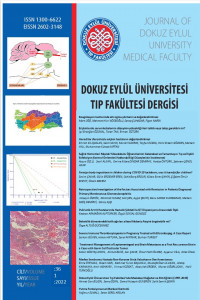Retrospective Investigation of the Factors Associated with Remission in Patients Diagnosed Primary Membranous Glomerulonephritis
Öz
Introduction: The present study aims to investigate the demographic, clinical, and pathological characteristics of patients followed up with a diagnosis of primary membranous glomerulonephritis (MGN) and the effects of the treatments applied on remission.
Methods: Sixty patients older than 18 years of ages, whose primary MGN diagnosis was confirmed by kidney biopsy and followed for at least 12 months between 2006 and 2012 were included in the study. The patients were divided into 3 groups according to the state of remission. The groups were compared in terms of their demographic, clinical, laboratory, and histopathological findings.
Results: Of the patients, 37 (63%) were male, the mean age was 55.7±14.8 years. While 44 (73.3%) patients were followed up with immunosuppressive treatment, 16 (26.7%) patients were followed only with conservative treatment. A high level of proteinuria (p=0.002) and male gender dominance were found in the group that received immunosuppressive therapy (p=0.01). A total of 18 (29.6%) patients had complete remission at the end of 12 months. Partial remission occurred in 30 (50%) of the patients. Female gender (p=0.02) and receiving immunosuppressive therapy (p=0.01) were independent factors associated with the development of complete or partial remission; the presence of lower glomerular sclerosis (p=0.03) was associated with complete remission. We did not find any relationship between the intensity of immune deposition and the state of being in remission.
Conclusion: Female gender and the presence lower glomerulosclerosis are indicators of good prognosis in primary MGN. In addition, immunosuppressive therapy positively affects the prognosis.
Anahtar Kelimeler
Membranous Glomerulonephritis Prognosis Proteinuria Remission.
Kaynakça
- 1. Seitz-Polski B, Dolla G, Payre C, Girard CA, Polidori J, Zorzi K, et al. Epitope spreading of autoantibody response to PLA2R associates with poor prognosis in membranous nephropathy. J Am Soc Nephrol. 2016; 27: 1517–1533.
- 2. Radice A, Trezzi B, Maggiore U, Pregnolato F, Stellato T, Napodano P, et al. Clinical usefulness of autoantibodies to M-type phospholipase A2 receptor (PLA2R) for monitoring disease activity in idiopathic membranous nephropathy (IMN). Autoimmun Rev. 2016; 15: 146–154.
- 3. Beck LH, Bonegio RG, Lambeau G, Beck DM, Powell DW, Cummins TD, et al. M-type phospholipase A2 receptor as target antigen in idiopathic membranous nephropathy. N Engl J Med. 2009;361(1):11-21.
- 4. Akiyama S, Akiyama M, Imai E, Ozaki T, Matsuo S, Maruyama S. Prevalence of anti-phospholipase A2 receptor antibodies in Japanese patients with membranous nephropathy. Clin Exp Nephrol. 2015;19(4):653-60.
- 5. Du Y, Li J, He F, Lv Y, Liu W, Wu P, et al. The diagnosis accuracy of PLA2R-AB in the diagnosis of idiopathic membranous nephropathy: a meta-analysis. PLoS One 2014;9:e104936
- 6. Cossey LN, Walker PD, Larsen CP. Phospholipase A2 receptor staining in pediatric idiopathic membranous glomerulopathy. Pediatr Nephrol 2013;28:2307–11.
- 7. Hoxha E, Harendza S, Pinnschmidt HO, Tomas NM, Helmchen U, Panzer U, et al. Spontaneous remission of proteinuria is a frequent event in phospholipase A2 receptor antibody-negative patients with membranous nephropathy. Nephrol Dial Transplant. 2015; 30: 1862–1869.
Öz
Kaynakça
- 1. Seitz-Polski B, Dolla G, Payre C, Girard CA, Polidori J, Zorzi K, et al. Epitope spreading of autoantibody response to PLA2R associates with poor prognosis in membranous nephropathy. J Am Soc Nephrol. 2016; 27: 1517–1533.
- 2. Radice A, Trezzi B, Maggiore U, Pregnolato F, Stellato T, Napodano P, et al. Clinical usefulness of autoantibodies to M-type phospholipase A2 receptor (PLA2R) for monitoring disease activity in idiopathic membranous nephropathy (IMN). Autoimmun Rev. 2016; 15: 146–154.
- 3. Beck LH, Bonegio RG, Lambeau G, Beck DM, Powell DW, Cummins TD, et al. M-type phospholipase A2 receptor as target antigen in idiopathic membranous nephropathy. N Engl J Med. 2009;361(1):11-21.
- 4. Akiyama S, Akiyama M, Imai E, Ozaki T, Matsuo S, Maruyama S. Prevalence of anti-phospholipase A2 receptor antibodies in Japanese patients with membranous nephropathy. Clin Exp Nephrol. 2015;19(4):653-60.
- 5. Du Y, Li J, He F, Lv Y, Liu W, Wu P, et al. The diagnosis accuracy of PLA2R-AB in the diagnosis of idiopathic membranous nephropathy: a meta-analysis. PLoS One 2014;9:e104936
- 6. Cossey LN, Walker PD, Larsen CP. Phospholipase A2 receptor staining in pediatric idiopathic membranous glomerulopathy. Pediatr Nephrol 2013;28:2307–11.
- 7. Hoxha E, Harendza S, Pinnschmidt HO, Tomas NM, Helmchen U, Panzer U, et al. Spontaneous remission of proteinuria is a frequent event in phospholipase A2 receptor antibody-negative patients with membranous nephropathy. Nephrol Dial Transplant. 2015; 30: 1862–1869.
Ayrıntılar
| Birincil Dil | İngilizce |
|---|---|
| Konular | Klinik Tıp Bilimleri |
| Bölüm | Araştırma Makaleleri |
| Yazarlar | |
| Yayımlanma Tarihi | 30 Nisan 2022 |
| Gönderilme Tarihi | 3 Eylül 2021 |
| Yayımlandığı Sayı | Yıl 2022 Cilt: 36 Sayı: 1 |


